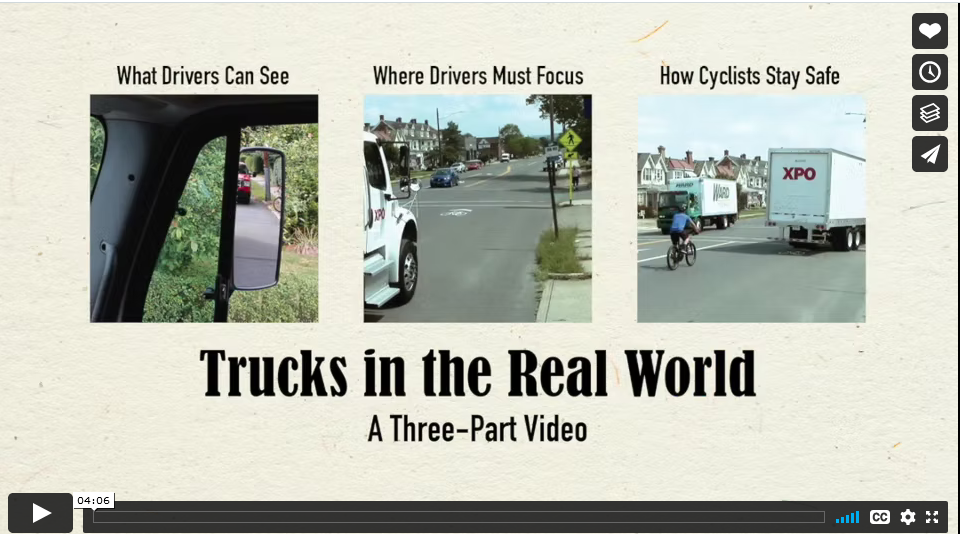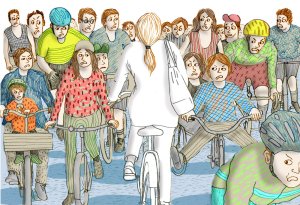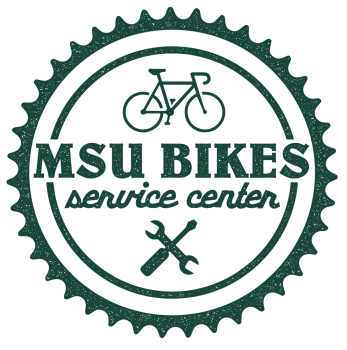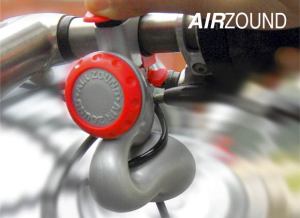
The most important thing when it comes to being safe on your bike is avoiding an accident, particularly ones with motor vehicles. Being seen and riding where you’re supposed to ride by campus laws (in the road or on pathways marked for bicycling NOT on the sidewalk – it’s called a sideWALK not a sideBIKE!) and predictably are things in your control and easily done. Riding legally is often way faster too!
Be Seen with Lights & Bright Clothing
Watch this video to understand why it’s important to stand out from your environment. Trust me, you DON’T want to be the bear if a car driver doesn’t notice you. Wear the brightest clothing you can find ALL THE TIME; safety-vests rock if you’d rather not flip for a new jacket (keep in mind that reflective clothing only works in the dark when lights are shined directly on the reflective material; many car drivers of older & many newer cars unfortunately fail to turn on their lights or their sensors are screwed up, so your reflectors will be no help).
We’re huge fans of promoting good lights for your bike, especially if you commute or ride in the road (as you should) around campus. We always stock a good selection of strong headlights and rear lights to fit any budget (and can special order better ones).
A tail light and rear reflector are required by MSU ordinance and the Michigan Motor Vehicle Code (related to bicyclists) when riding after dark, but if you ask any commuter or experienced bicyclist, they’ll advise you to run with tail and head lights (strobe is best) all day (use rechargeable batteries or the USB rechargeable type lights and you don’t have to worry about the expense of replacing batteries).

Why use lights during the day? Well, when you ride in and out of dark shadowy areas of the roads you can become almost invisible to a motorist who’s eyes haven’t adjusted to the darkness in that split second which could cost you dearly. A report published by the Mich. Dept. of Transportation summarizing crash statistics for 2012 are very sobering; “78.9 percent of all bicyclists in motor vehicle crashes and 15 of the 20 bicyclists killed were riding during daylight hours.” A summary of data for 2013 crashes are now available here which again found “peak hours for bicyclist involvement in crashes were from 3:00-5:59 PM”.
Check out a 2017 WSJ article on the topic:
“How Cyclists Can Stay Safe on the Road – Bright colors, bright lights and positioning on the road can help cyclists be more visible to drivers”
Still not convinced? Car and motorcycle manufacturers have recognized the great safety benefits of Daytime Running Lights for years and many now make their headlights come on automatically all the time for the safety of their drivers. Bicyclists can also benefit from all that R&D. Unfortunately many car drivers of older cars fail to turn on their lights so reflectors will be no help with your visibility in those cases.
Read more on this topic on this updated post here.
MSU Bike Safety Videos
The MSU Bike Safety Collaborative, a project of the MSU Provost’s Healthy Campus Initiative (directed by Prof. and Assoc. Dean Kami Silk and graduate student, Andy Grayson), after two years of research (2014-2016; see research poster- presentation here) created a video that encourages people to ride on the road and paths that are designed and marked for bicycling rather than sidewalks.
Check out this bike safety video that a group of MSU Communications Arts students (directed by Katelyn Patterson; all volunteers on this project) created for AOP bike tours done in previous years. Using a bit of slap-stick humor hopefully makes the sometimes boring subject more entertaining.
Picking a Safe Route


Choosing a safe route is probably the most important key to your safety as a cyclist. Our biggest piece of advice: Stay off the sidewalks. Why? It is against most city ordinances to ride bikes on sidewalks (including the MSU Campus Ordinance) as it’s more dangerous for everyone including the bicyclist. If you’re going more than 10 mph, even if there are no bike lanes, you have a legal right to ride in the road (just make sure you’re highly visible, ride in the same direction as motor vehicle traffic and follow the same rules of the road as motor vehicles).
It seems safer to ride on the sidewalks but cars just don’t check sidewalks for bicyclists when they approach a roadway to make a turn and, on our campus as with most of the cities in the State of Michigan you have NO LEGAL PROTECTION if you do get hit while riding your bike through a cross-walk as a pedestrian as you’re required to be walking your bike to be legally considered a pedestrian. National statistics as well as our own campus research show that the overwhelming majority of bike-auto accidents occur when the bicyclist is riding on a sidewalk.

We’ve noticed an increase in cases of wrong-way bicycling, that is riding against traffic, particularly where there bike lanes. This is very dangerous for both the wrong-way bicyclist and other bicyclists who have to pass such unpredictable bicyclists (aka “Salmon” after the fish who swim up river) as last minute decisions as to how to pass someone when there are no rules for such behavior can result in collisions, swerves into traffic, etc.
For more convincing graphical presentations and resources read more here courtesy of John Allen’s Bicycle Facilities, Laws and Programs pages. From that web page:
“…riding on a sidewalk is not necessarily safer and in fact, …the risk is approximately four times that of riding on the roadway with traffic.”

If you’d like to learn more about why it’s safer to ride in the road and exactly WHERE to ride in the road you should review the great animations on this website courtesy of the Cycling Savvy folks at Commute Orlando. This one in particular shows you where and why you should ride out in the travel lane. This page of theirs gives a great one-page tutorial on where, how (& why) to ride safely.
Riding Safe Tips
Once you’ve got your basic safety equipment all set (see below for our recommendations), the next major area of keeping safe while you ride is how you ride and react to aggressive or clueless motorists/pedestrians/other cyclists. The Bicycle Safe website lists common types of bike-to-motorist accidents and how to avoid them. The League of Illinois Bicyclists has a video on the topic of riding safely and defensively on the roads.


“LEO to Cyclists: No law obligates you to endanger yourself. “
The Cycling Savvy organization has a wonderful collection of animations demonstrating many safe cycling techniques here and also offer face-to-face classes around the country.
The League of American Bicyclists has published a series of online Ride Smart videos which are also an excellent way to learn online for free. Their newer Smart Cycling Quick Guide for safe bicycling is also available for viewing online here in both English and Spanish. The League also offers face-to-face classes throughout the country for more intensive learning. Their .
If you’re interested in learning more about safe bike riding, consider taking a class from the MSU Bikes Service Center. We occasionally offer classes focused on this topic. Join our MSU Bike Community Listserv (a Yahoo group) to learn when our bike classes and other MSU bike-related events get announced.
Helmets
We highly recommend the use of helmets when riding around campus – or anywhere, for that matter. We had a student wearing a helmet stop by the Service Center who shared one of the simplest summaries we’ve ever heard for why wearing a helmet makes sense:”When people say ‘helmets look stupid,’ I just say ‘Would you rather look stupid or be stupid?“
- If you’re not convinced, perhaps you’d like to read some stories about helmets saving lots of lives? (presented by the Bicycle Helmet Safety Institute).
- The MSU Bike Project’s co-founder, Gus Gosselin, has his own story about how his helmet saved his life a few years back, so you don’t have to go far to know it’s worth it.
- Here’s a great site called “Safety is Sexy” to help people see helmets as sexy (yes, sexy); has a ton of great materials, photos, videos, etc. promoting bike helmets and other bike safety issues.
- There was a British study published back in 2006 that concluded wearing a helmet and dressing like an experienced bicyclist resulted in motorists passing closer than if you wore no helmet and especially if you appeared to be female. There has been a lot more research published since then including some excellent lampooning of that British study; see a summary of all that here. The summary is published by the Bicycle Helmet Safety Institute.
Other Accessories for Improving Safety
Eye Protection
Protecting your eyes is highly recommended while you’re riding. Use tinted during the day and clear for riding after hours or in low-light conditions. Prices range from bargain basement on up.
Fenders
Using fenders will keep your tires from picking up road debris and throwing it in your eyes. Most people associate fenders with keeping water and mud off yourself, but overlook the protection they provide your eyes. We stock a good supply and variety of them.
Bells and Horns
Yes, we’re all about bells and horns, too. How many pedestrians, cyclists, motorists are busy talking on their cell phones or listening to their iPods or other radios? Get yourself a nice little bell for letting peds know you’re about to pass them and then consider something stronger like the AirZound Bike Horn for getting yourself noticed by motorists in no uncertain terms. We stock a good selection of bells and horns, including the AirZound.
MSU Ordinances, Michigan Law, Legal Assistance and Case Studies
MSU’s ordinances related to bicycling are slightly different from Michigan’s Motor Vehicle Code. The League of Michigan Bicyclists has published a very nice summary of the Michigan Motor Vehicle Code which pertains to bicycling here. They’ve also published a number of legal columns by two Michigan attorneys (Sarah W. Colegrove and Todd E. Briggs) who specialize in litigating bicycling-related cases. You can read those past columns and get their contact information here. BikeLaw Michigan is another great legal resource headed by an avid Lansing-area bicyclist.
What to Do if Hit by a Car
We have many bicyclists come into our shop having just had an accident and way too often they report not having reported the incident and telling the driver they’re OK and not getting names or anything only later to find out that they’re injured or that their bike is damaged beyond repair. Don’t let this happen to you.
The following list is excerpted from an LMB legal column in the site referenced above.
- Don’t admit liability by stating the accident was your fault.
- Call the police (911 if there are serious injuries) and make a report. (The MSU Police non-emergency number is 517-355-2222 for non life-threatening injury accidents).
- Get driver’s contact and insurance information.
- Get witnesses’ statements and contact information.
- Get the officer’s precinct number and contact information.
- Seek immediate medical treatment for injuries.
- Report incident to your auto insurance company.
- Report incident to your homeowners/renters insurance company.
- Take photos of crash scene, injuries and bicycle.
- Request copy of police report.
- Keep folder of all crash information (notes, receipts, log, insurance information, etc.)
- Contact an attorney to advise you of your rights.
MSU’s Commitment to Improving Traffic Safety
In 1995, MSU’s administration made the decision to make improvements to campus roads to improve traffic safety. This has resulted in a drop in automobile-related accidents that result in injuries to approximately 90 percent fewer accidents as of the 2008 accident report. As a result, not only have hundreds of potential accidents been avoided, but MSU was awarded an Outstanding Contributions to Traffic Safety Award from the Governor’s Traffic Safety Advisory Commission in 2006. Click here to read the award announcement.
A new campus policy calling for their construction/ addition to all new road projects was also adopted at the same time to improve bicycling safety and reduce accidents with automobiles and pedestrians. MSU is approximately 60 percent done with installing bike lanes on all campus (MSU-controlled) roads as of the end of the 2012 construction season.
The All University Traffic and Transportation Committee advises MSU’s Chief of Police on traffic and transportation safety issues and serves as a way for the campus community to have input to the administration regarding related issues or concerns to include parking of all vehicles (motorized and non-motorized). Their Comment form is a great way to report problems or concerns on campus and now features a new mapping tool w/ the ability to upload photos w/ your submission.
Questions or suggestions for more safety information?
We’d love to add more to this page. Have a story or a tip you’d like to share? Comment below or contact Tim Potter at pottert@msu.edu







One thought on “Safety Tips”